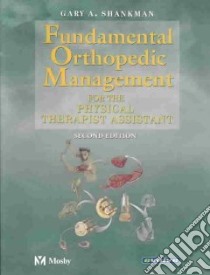Fundamental Orthopedic Management for the Physical Therapist Assistant - 9780323020022
Un libro in lingua di Shankman Gary A. Collins Mitchell A. (CON) Capps Sandra Eskew (CON) edito da Elsevier Science Health Science div, 2004
- € 45.70
- Il prezzo è variabile in funzione del cambio della valuta d’origine
While other texts emphasize only technical application of the basic principles of orthopedic science, this text demands critical thinking and enhanced awareness of principles and application of the foundations of orthopedic science. Tailored to the needs of the PTA, each chapter builds on previous information and is complete with challenging review questions. The 2nd edition also includes a stronger emphasis on the fundamentals on exercise science with focus on tissue healing, orthopedic injury, and how to bridge the gap between basic science and physical healing. It also includes six new chapters and the addition of seven appendices.
- Part I: Basic Concepts of Orthopedic Management begins with the essential concepts of teamwork and shared responsibility within the Physical Therapy team and then develops an understanding in the basic areas of flexibility, strength, endurance, balance, and coordination
- Part II: Review of Tissue Healing, introduces appropriate concepts of injury and repair of musculoskeletal tissue.
- Part III: Common Medications in Orthopedics, focuses on common medications used in orthopedics. Knowledge of the actions and side effects of medications and their possible impact on treatment is important for the PTA who is treating patients.
- Part IV: Gait and Joint Mobilization, provides information that will improve the PTA's ability to treat a patient with gait disability.
- Part V: Biomechanical Basis for Movement, deals with the basis of human movement. This section's presentation of introductory mechanics precedes orthopedic pathologies and therapeutic interventions by pulling together essential basics of anatomy, physiology, tissue healing, kinesiology, and principles of therapeutic exercise.
- Part VI: Management of Orthopedic Conditions, serves as the foundation of the text, covering the ankle, foot, and toes; the knee; the hip and pelvis; the lumbar, thoracic, and cervical spine; the shoulder; the elbow; and the wrist and hand.
- Each chapter is complete with challenging review questions that include substantial fill-in, essay questions, short answer, and important critical thinking applications.
- More than 530 photos and illustrations help readers understand new concepts and procedures.
- A unique new chapter, The Role of the Physical Therapist Assistant in Physical Assessment, offers a critical review of essential knowledge related to systems of the body and includes a systems approach to physical assessment specifically applied to PTA.
- Another unique new chapter, Physical Agents Used in the Treatment of Common Musculoskeletal Conditions, bridges the gap between basic science, assessment, and clinical utility of physical agents.
- The addition of a chapter on Orthopedic Biomechanics and Kinesiology helps broaden the scope of and enhance the clinical application of kinesiology.
- The new chapters Composition and Function of Connective Tissue and Neurovascular Healing and Thromboembolic Disease contain new and updated relevant information on ligament healing, bone healing (substantial increase), cartilage healing, and muscle and tendon healing. This new information is critical for the transition to applied principles of orthopedic injury and rehabilitation techniques.
- The new chapter on Concepts of Orthopedic Pharmacology is designed to enhance the knowledge base of a PTA dealing with patients on anti-inflammatory medications and antibiotics. This chapter introduces information concerning routes of drug administration, bioavailability, antibacterial classifications of drugs and related offending organisms, infections with total joint arthroplasty and fractures, as well as an introduction to anti-inflammatory medications.
- The addition of appendices broadens the knowledge base of the PTA student and assists in improving the PTA student's learning capacity and skills/knowledge in practice. They also provide enhanced knowledge of orthopedic and neurovascular anatomy.
- The 2nd edition has new illustrations, tables, and charts related to orthopedic and neurovascular anatomy in each chapter related to specific orthopedic injury and rehabilitation.
- The addition of Answers to Review Questions reinforces learning for the student and improves the PTA's skills/knowledge in practice.
- The glossary is enhanced with new terms and includes new information on biomechanics, biomaterials, medications, and names of surgical procedures.
Informazioni bibliografiche
- Titolo del Libro in lingua: Fundamental Orthopedic Management for the Physical Therapist Assistant
- Lingua: English
- Autori : Shankman Gary A. Collins Mitchell A. (CON) Capps Sandra Eskew (CON)
- Editore: Elsevier Science Health Science div
- Collana: (Paperback)
- Data di Pubblicazione: 25 Gennaio '04
- Genere: MEDICAL
- Argomenti : Orthopedics Physical therapy Physical therapy assistants
- Pagine: 541
- Dimensioni mm: 266 x 209 x 25
- ISBN-10: 032302002X
- EAN-13: 9780323020022


